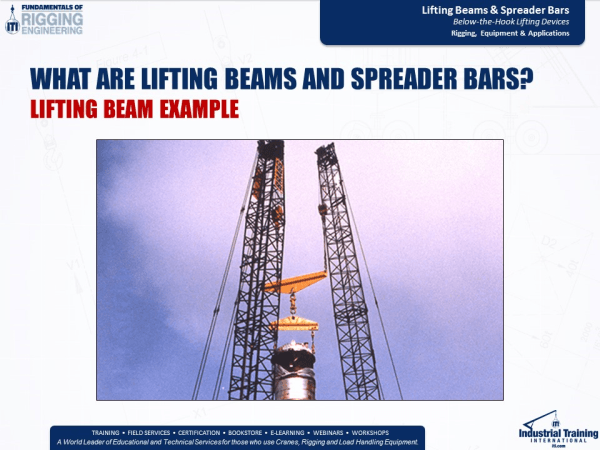

Lifting beams and spreader bars have become an integral part of complex crane, rigging, and lifting activities. In response, a large below-the-hook-lifting devices market has grown supporting projects with some exceptional solutions (see Modulift, Liftmax, Caldwell, Tandemloc, Bushman, and Peerless to name just a few). Additionally, the need often arises for engineers and designers to create a custom lifting device for a specific project. Depending on your jurisdiction, there are design considerations, guidelines, and regulations. Fortunately, on earth, physics does not change depending on your locale, so carefully crafted design considerations in one jurisdiction should "work" in others. Let's learn what an absolute expert has to say about lifting beams, spreader bars, and the design thereof. "Structural Design Factors" and "Lifting Beams & Spreader Bars" are two lessons in the Fundamentals of Rigging Engineering Program taught by David Duerr, PE, a leading engineer in the USA and Principal/Owner of 2DM Associates, Inc. 2DM provides professional engineering and technical services directed to the needs of the specialized heavy lifting and transportation industry including lift planning and engineering for mobile cranes, alternative load handling equipment, and marine transport. Mr. Duerr has authored and released a book titled Telescopic Hydraulic Gantry Systems, and is preparing another work on mobile crane load spreading. In short, lifting beams and spreader bars are one of many areas of expertise for Mr. Duerr. These lessons are two of forty included in the Rigging, Equipment & Applications Course taught by Duerr, Larry Means (Means Engineering), Mike Parnell (ITI), Skip Ohman (The Crosby Group), and Keith Anderson (Bechtel).
4. Purpose of Design Factors Mr. Duerr explains that t he purpose of a design factor is to compensate for unknown load characteristics such as its weight. The more accurately these load characteristics are known, the lower the design factor can be and still provide adequate safety. In the slide below, Duerr explains that if the strength of the material and the load's weight was known "exactly", a known design factor would be a fitting, practical solution for our project. Though, because of many factors, structural design factors are benchmarked at different levels in design standards around the world.

5. Structural Reliability The "reliability" of a lifter is the probability of survival subject to the statistics of loading and strength based on the chosen design factor. The Reliability Index is based on the mean and standard deviation of the load effects and strength. After Mr. Duerr explains the mathematical formulas behind reliability, he emphasizes that "once a design provides a reliability of 99.9. % for the given service conditions, any further increase in the design factor does nothing to improve the reliability or safety of the lifter". It is at this point that the desired design factor is achieved.

6. Proof Testing If operating in the USA, OSHA's rigging equipment regulation (29 CFR 1926.251) requires a 125% proof test for "lifting accessories". The June 14, 2002 interpretation issued by OSHA states that lifting devices like beams and spreaders are covered by this regulation, and must be proof tested. Various other jurisdictions have similar requirements. Note: According to ASME B30.20, proof testing is only a recommendation, not a requirement.

If you'd like to learn more about these lessons and others in the Fundamentals of Rigging Engineering Program, download the Interactive Program Preview.
Fundamentals of Rigging Engineering is ideal for lift planners, rigging engineers, and other key personnel who plan and execute crane and rigging activities.
The Program Preview will outline the:

To learn more, visit riggingengineering.com or call Christina Lanham, ITI Manager of E-Learning at 800-727-6355.